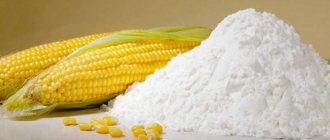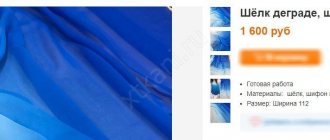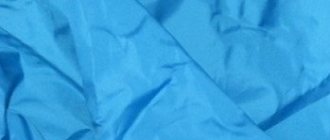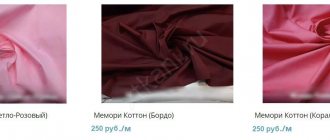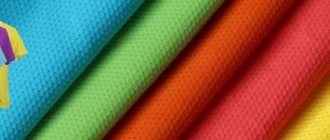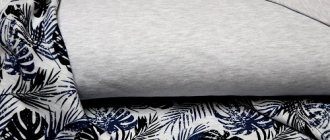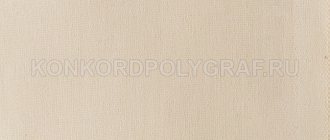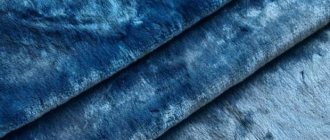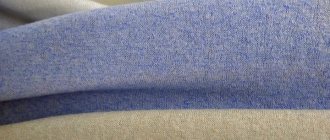Pashmina is a very thin and soft material made from the down of mountain goats. From the Persian language the word “pashm” can be translated as “soft gold”. The fabric is very expensive because the undercoat is collected and spun by hand, and one animal only produces about 80 grams of processed and pure down, suitable for creating garments.
Pashmina and cashmere are often confused because both materials are made from the wool of the same animal species, but they have their own differences. Let's take a closer look at the production of pashmina, the properties of the material, care features and compare it with cashmere.
Description of the fabric, its history
Real pashmina is shawls and stoles made from an elite variety of well-known cashmere. Unique material, rare and expensive. The products are very soft, not at all scratchy, pleasant to the touch. Thin, airy, and at the same time very warm. Owning them is pure pleasure. How to wear a pashmina: we have provided an example photo. We also invite you to read about the amazing features of fine linen fabric, an amazing fabric from the past.
A stole measuring 80x200 cm will weigh up to 100 g and can easily fit into a woman’s handbag. The weave of the fabric is not very dense and not always uniform, but due to the small thickness of the threads, this does not look like a flaw. Coloring - plain or with patterns. The edges of the products are raw or fringed.
The principality of Kashmir, which existed in the Himalayas many centuries ago, is considered the birthplace of pashmina. But in fact, the art of creating this finest thread was (and is) also mastered by the inhabitants of India, China and Pakistan. Each stage of creating the finest fabric required the participation of a separate craftsman (or several craftsmen): a carder, a dyer, a spinner, an artist, a weaver, and sometimes an embroiderer. Often, working with wool was the work of several generations of residents of entire villages.
Such fabric has always been very expensive, accessible only to rich people. Moreover, until the 18th century, only the rulers of the countries where it was produced could afford it. What pashmina looks like, what kind of material this is, Europe learned in the 18th century. Parisian fashionistas quickly fell prostrate in front of the weightless stoles, whose toilets, for all their sophistication, sometimes made their mistresses freeze. From then to the present, pashmina has been a status accessory that has always been in demand. Additionally, read the article “Angora fabric - photo and description of the material”, you will be interested.
Types of Pashmina
Authentic pashmina is made from mountain goat down, without any additives or impurities of other threads and can be single or double (from double thread). In the latter case, the matter turns out to be denser and warmer. Also, according to the manufacturing method, openwork fabric and plain weave fabric are distinguished.
In terms of quality, it is customary to distinguish several types of pashmina:
- Boxing ring. This is the highest quality fabric, made from fine thread, made by the most skilled craftsmen.
- Classic pashmina without cashmere or silk additives, hand-woven.
- Pashmina with added silk (up to 40%). Such fabric can be produced industrially, due to the fact that silk gives fluff strength during processing.
The latter type can only be called pashmina at a stretch, but this fabric is also of high quality and is in demand. Its price is not much lower than the traditional pashmina.
Composition and manufacturing process, cost
First, let's make some clarifications regarding things defined as “pashmina”: what is “composition” in this case. The word “composition” would not be entirely appropriate here. The product itself is named according to its type (stole, shawl, scarf), and on the label, opposite the “composition” line, the word “pashmina” is indicated, used as the name of the thread. The only raw material used for its production is the down of the Himalayan mountain goat. And here lies the difference between such products and cashmere ones:
- Pashmina is 100% down, without guard hair. This is the same standard for all countries.
- Cashmere is only 40-80% fluff, the rest is wool.
We figured out what pashmina is in the composition of the fabric. Next is the method of its production. Each stage of creating an original stole is entirely handmade. It includes:
- Collecting, carding and dyeing the down of the Himalayan (mountain) goat.
- Down spinning and weaving on a handloom.
- Embroidery and fringe creation are optional.
The cost of finished accessories under such conditions is very high. Hence the high price for things whose labels contain the treasured word “pashmina”: from 15 thousand rubles for a two-meter stole. Most of what is sold in Russia is from India.
It should be noted that on sale today you can find products at a slightly lower price that have the word “pashmina” in their name, but in fact are not it. They contain only a small percentage of goat fluff, and the rest is silk at best, acrylic at worst.
Additionally, we invite you to read about the properties of a fabric called “double-thread”.
How the material is made
The best fabrics are made from goat down.
Far and high in the Himalayas, at an altitude of 4500 meters, shepherds herd Kashmiri, or cashmere goats with large and beautiful curled horns. The climate where animals live is very harsh - it’s cold in the mountains. Goats are covered with warm wool, which perfectly protects them from cold weather and gusts of wind. However, the coat has its own peculiarity and consists of two layers - soft and delicate fluff on the inside and hard guard hair on the outside.
The best fabrics are made from down. In the spring, the animals are combed by hand, with special attention paid to the belly and neck areas of the goats. The resulting fibers are incredibly thin, only 14 microns, while human hair is 50 microns thick. It is believed that only goats living in northern India, Pakistan and China have such fine wool.
The collected undercoat is sorted by length and quality, cleaned of impurities, and only then spun using hand spinning wheels. The process of making such yarn is incredibly labor-intensive; it requires not only experience and skill, but also patience and delicacy.
Finished yarn is completely unsuitable for industrial use; automatic machines can damage it, so many products are made by hand. Machine knitting is very smooth, while hand-knitted shawls have slightly uneven edges. There is even a special tradition according to which the edges of things made of goat wool are not specially processed in order to demonstrate the result of manual labor. The product alone can cost tens of dollars.
Advantages and disadvantages, scope
First, about the pleasant things, about the advantages of the material. 100% pashmina, what does it mean:
- Aesthetic value. Some products are real works of art. This can be seen in any photo requested from a search engine.
- Excellent thermal insulation qualities with low weight and without compromising breathability.
- High tactile characteristics. This fabric is pleasant to touch, it is soft, gentle and warm under your hands.
- Long service life. However, it all depends on how to store the pashmina, how to wear and care for it.
There are also disadvantages of such woolen accessories:
- High price.
- Doesn't protect against wind at all. Read about the characteristics of alova fabric and why you will never get cold in it in our other article.
- Easily damaged if not properly cared for.
- Like any wool, it is an excellent treat for moths.
Important: everything that has the right to be called “pashmina” is strictly finished products: scarves, shawls, stoles or shawls. Clothes are not made from this thread. There are no sweaters, capes or dresses made from it. If you are offered a linen sold by the meter, it is just fine wool, nothing more.
Celebrity textile fans
Once upon a time, Napoleon Bonaparte threw a pashmina shawl over Josephine’s shoulders, on which three craftsmen worked for a year. The woman froze with delight, because, embroidered with gold thread, the finest fabric was truly a royal gift.
The invincible “Agent 007”, Peter Brosnan, has in his wardrobe jumpers made from Kashmiri yarn from Ballantyne, and Silvio Berlusconi prefers items from Indian wool from Brunello Cucinelli.
Madonna, Gwyneth Paltrow, Angelina Jolie collect pashminas from different brands and proudly wear them to parties, as well as to walk along the red carpet.
It is not for nothing that Indian textiles made from the finest mountain goat fluff are called “wool diamonds”. Pashmina, thanks to the exclusive quality and softness of the yarn, has won fans around the world who are willing to pay a high price for the opportunity to feel the gentle warmth and soft charm of a unique fabric.
Product care
The first thing you should know is that pashmina material does not like washing. The ideal option is dry cleaning in a place that specializes in such fabrics. As a last resort, you can wash it, but observing the following rules:
- Water temperature no more than 25°.
- The detergent is special for wool, with lanolin, and in no case is it an ordinary powder or bleach.
- The last rinse is with a special conditioner.
- Don't twist it! We just lightly squeeze the thing in our hands. Dry naturally on a horizontal surface.
Other care features: things should be protected from exposure to hot air and direct sunlight; avoid ironing, at least - at minimum temperature and from the inside out; protect from moth damage.
Finally, a little advice: a thick terry towel will help remove water from delicate wool fabric faster. We spread it on a horizontal surface, with a stole/shawl on top. If the item does not fit along the length, fold it in half. Now roll it all up and leave it for 10 minutes. During this time, the terry cloth of the towel will draw out excess moisture from the product. Further drying - according to the recommendations above.
In order not to miss the release of other equally interesting articles, add our site to your browser bookmarks!
We also invite you to watch an informative video in which you will learn how to beautifully put on a shawl or stole:
How can you tell if a product is made from 100 percent pashmina?
As a rule, in an attempt to increase their profits, unscrupulous sellers try to pass off cashmere or, even worse, yarn made from sheep wool (sometimes with the addition of viscose) as pashmina. Fortunately, none of these materials have the properties of real “soft gold”, so a fake can be quickly recognized using simple tests:
- Test by touch. Pashmina is a soft and delicate material. It does not prick when in contact with skin. To verify the authenticity of the fabric, a product made from it is applied to the neck, where the sensitivity of the skin is highest. If there are no unpleasant sensations, the pashmina is real.
- Visual inspection. The presence of constrictions, knots and other irregularities on the product is a good sign, since even experienced craftsmen cannot avoid such defects when weaving by hand. A perfectly smooth surface of the fabric, on the contrary, is a sign of machine work, and therefore a fake.
- Water test. The color of pashmina does not change when the fabric gets wet (which cannot be said about most other materials). By lightly sprinkling the item with water, you can immediately determine whether it is a fake or an original.
The main reason for caution is the suspiciously low price of the product stated by the seller. Real pashmina is expensive no matter where it is bought, and even in the homeland of the fabric, India, traders rarely offer tourists discounts on the purchase of their “soft gold”.
Fabric reviews
Lyudmila “Oh, this is a super thing, I love it impossible. They gave me a pashmina scarf; I would never have decided to make such a purchase myself. Indeed, very soft, tender, and warm in it. And there are no words for how beautiful it looks. In general, I have nothing but praises.”
Ekaterina “For a long time I walked and dreamed of a pashmina, fought with that toad that did not allow me to fork out for a stole. In the end I bought it and did not regret it. True, I spent several days choosing, there were so many interesting colors, I didn’t know which one to choose, so that I wouldn’t regret later that I didn’t choose this one or that one. It’s a beautiful thing, warm, warm, although thin, almost translucent.”
If your favorite thing is stained
It is better to immediately wash the newly planted stain with water, first sprinkling it generously with salt. Old stains can be treated with a solution of citric acid (2 teaspoons per glass of water). If a mark remains from fruit, do not try to wash it off with soap - on the contrary, it will set the stain.
The tea mark on the pashmina can be rubbed with a swab dipped in a mixture of ammonia (half a teaspoon) and glycerin (2 tablespoons). Glycerin will also help remove egg stains.
If an ink stain appears on the product, a solution of ammonia and baking soda (1 teaspoon per glass of water) will help.
Greasy marks on dark pashmina are removed by ironing with a warm iron through paper napkins placed on both sides of the stain. Remove stains from a light-colored product with a mixture of gasoline and burnt magnesia (sold at a pharmacy). Apply the mixture to the stain, wait until it dries, and remove with a brush.
Makeup stains can be easily removed with alcohol or refined gasoline.
Some tips
In case you love wearing pashmina, you need to know that it needs to be given some rest. So, 2-3 days of respite will be sufficient for her.
Do not wear the shawl with rough fabrics, leather or metal accessories. All this can harm the finest cashmere.
To buy real pashmina and not be mistaken, remember that pashmina is not only incredibly warm, but it is also a delicate and soft material. Touch it to your face - you should not feel any scratching or rubbing. Inspect the seams carefully. A real shawl must be woven by hand, since the finest wool cannot be knitted by machine. You can moisten the pashmina with water. If it retains its color even when wet, then it is actually a real shawl.
Exclusive Features
Indian fabric made from the wool of Kashmiri goats is distinguished not only by its beauty, but also by other properties that are important for wearing products. Benefits of Pashmina:
- does not cause allergic reactions;
- softness;
- despite the thinness of the textile, it warms and retains heat perfectly;
- lightness of canvas and products made from it;
- the fabric “breathes”, allows air to pass through, which has a beneficial effect on the skin.
Sash
This is a very unusual way to complement a business suit. If the dress code allows some liberties, then a plain pashmina tied like a sash around the waist will look great. This method is best combined with black, slightly tapered trousers and a white shirt. And in a casual version, such a detail can be complemented by the simplest combination of dark blue jeans and a colored T-shirt.
To do this, it is enough to fold the panel several times in length, to the required width, and make several turns on the trouser waistband. But you will have to practice tying a neat knot so that it doesn’t turn out too big. That is why it is better to choose very thin small pashminas for tying with a sash.

